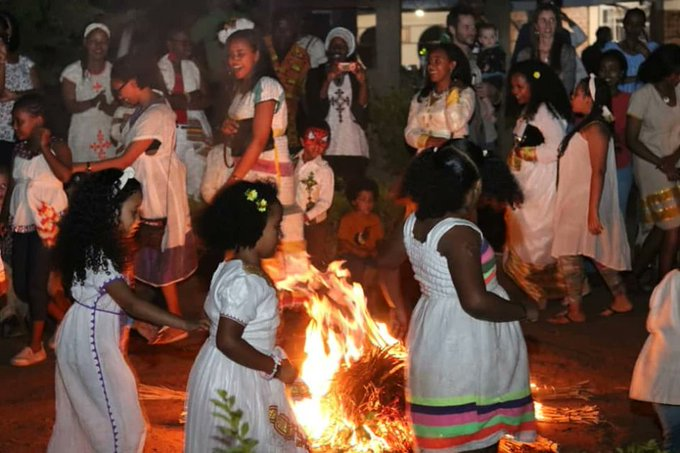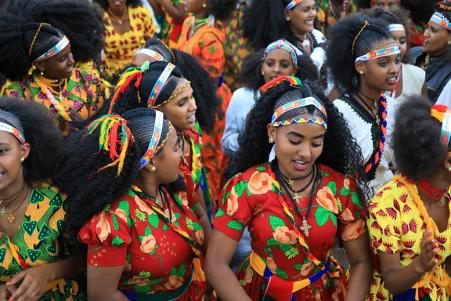Popular Afrobeat singer David Adeleke , widely known as Davido, recently performed at the Ethiopia New Year party as the country enters 2017.
As seen in a video trending on social media on Wednesday, thousands of Ethiopians trooped out at the event in Addis Ababa, the country’s capital, celebrating their unique new year.

To the surprise of many fans on social media, Ethiopia is seven years behind the rest of the world, rightly so, because the country follows its unique calendar system, known as the Ethiopian calendar or Ge’ez calendar.
The Ethiopian New Year, also known as Enkutatash, is different from the rest of the world as it falls on September 11 or 12 during a leap year.
The word Enkutatash means the ‘gift of jewels’ that also represents the end of the rainy season, the time of year during which the Ethiopian landscape is covered with bright yellow flowers called Adey Abeba.

Today, Ethiopians bade farewell to 2016 E.C and received the New Year 2017 E.C.
Why is the Ethiopian Calendar different?
Ethiopia is located in East Africa and is Africa’s second-largest country in terms of population. It uses a unique calendar system different from the widely used Gregorian calendar. The Ethiopian Calendar, also called “Ge’ez,” is seven to eight years behind the Gregorian Calendar.

The main reason for this difference is that the Ethiopian Calendar places Jesus’ birth in 7 BC (Before Christ) and begins its count from that point. On the flip side, the Gregorian calendar marks Jesus’ birth as 1 AD and initiates its date count from that time.
In the era before Christ (BC), days were counted backward, and eras were labelled based on the notion of when Jesus was born. BC means “Before Christ,” and AD stands for “Anno Domini or in the year of the Lord.” In non-Christian countries, AD is replaced with CE, “Common Era,” and BC to BCE, “Before the Common Era.”
There are eight years of difference between 7 BC, when the Ethiopians believed Jesus was born, and 1 AD, which followed the Gregorian calendar. From 7 BC, the year is counted to 6 BC, 5 BC, 4 BC, 3 BC, 2 BC, 1 BC, and 1 AD. This, and other astronomical calculations, explain the years apart in both calendars.
Evolution of calendar systems in history
A calendar system is a way people measure the passage of time. Ancient humans deployed different ways to determine the length of the year and track seasons to organise agricultural activities, plan religious ceremonies, and coordinate cultural events.
Throughout history, calendars have been shaped by a combination of cultural practices, religious beliefs, and astronomical observations.
The evolution of the calendar starts with the Mayan long calendar, the Roman calendar, the Julian calendar, and the Gregorian calendar, among others.
The Julian calendar is based on the solar system. It calculates time and dates based on the Earth’s orbit around the sun. It was used for about 1,600 years but was criticised for not accurately reflecting the time it takes the Earth to revolve around the sun.
The Julian Calendar sets a year at 365.25 days, and since no year matches the extra 0.25, a year is rounded up to 365 days and 366 days in a leap year every four years to align the calendar with the solar year more closely.
It was later discovered that the time of the year, according to the Julian calendar, was off by 11 minutes, which led to Pope Gregory XIII’s calendar reform in 1582.
The new calendar was named after Gregory, who made it the Gregorian calendar. The Gregorian calendar adapted the Julian calendar with few updated features.

Other unique calendars today include the Chinese calendar, Hebrew calendar, Hijra calendar, and Hijiri Solar calendar, among others.
These calendars are used solely as the primary calendar systems in countries that adopt them. Some use these native calendars alongside the Gregorian calendar for both religious and civil purposes.
One obvious fact in these trends is that calendars in different cultures evolved from different timekeeping systems. This is the case with the Ethiopian Calendar.
Some unique features of the Ethiopian Calendar
The Ethiopian calendar is based on the same astronomical calculations as the Gregorian calendar, albeit with some differences in the calculation method and starting point.
A full year in Ethiopia comprises 13 months. The first 12 months have 30 days each, the 13th month has five days, and in a leap year, it has six days.
While the Gregorian calendar celebrates the new year on January 1 and Christmas on December 25, Ethiopia’s new year starts on September 11 or Meskerem 1, while Christmas is celebrated on January 7.
Unravelling some myths around the Ethiopian Calendar
DUBAWA engaged an Ethiopian, Ms Hanna, in a dialogue session to demystify some myths about the Ethiopian Calendar.
One of the myths around the Ethiopian Calendar is that one becomes eight years younger when one travels to Ethiopia.
“Travelling to Ethiopia wouldn’t make someone physically younger by eight years. The difference in calendars doesn’t affect one’s age or the passage of time in a biological sense. It’s merely a difference in how years are calculated and recorded,” Ms Hanna noted.
-dataphyte